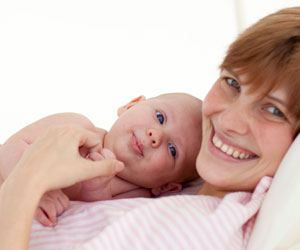
Here, thanks to the wisdom of mamas and care providers, are a handful of soothing solutions to help you find comfort for your achy private parts during those first few postpartum weeks.
’Rhoid rage
“About half of new moms get hemorrhoids during pregnancy and childbirth, but “no one talks about them!” laments St. Louis Park, MN, mom Jennifer Wetherall. She relied on witch hazel pads to help ease the discomfort. Over- the-counter topical creams or prescription ointments can also help shrink those swollen, protruding veins. Patricia Burkhardt, head of the midwifery division at New York University College of Nursing, recommends something she admits has a bit of an ick factor. “Use your lubricated fingers to gently push hemorrhoids back inside,” she says. “That’s where they belong.” Of course, common sense should be the rule, she counsels. “If what you’re doing helps, keep it up. If not, try something else.”
Other ways to cope: Nursing mamas can find relief by breastfeeding in a side-lying position. And don’t forget that soothing sitz baths, a high-fiber diet to prevent constipation, no straining on the toilet, and (if things get really uncomfortable) a stool softener can all help ease the pain.
Tender tush
Pushing that little one out can leave you feeling like you’ve got a bowling ball between your legs. At Meadowlands Hospital Medical Center in Secaucus, NJ, Margaret Calzaretta, clinical nurse manager of maternal child health, advises ice packs for the first 24 hours, then warm sitz baths for as long as you like after that. The key is comfort: If you prefer warmth, take sitz baths. If cold is more soothing, gather the ice packs. “Those absorbent pad/ice pack ‘thingies’ in the hospital were a godsend,” says New York mama Erika Rasmusson Janes. “I wish I’d swiped about a dozen of them!” You can also make use of what you have on hand at home—a newborn-sized diaper, saturated with water and frozen, makes for a soft, soothing pack, too.
Go with the flow
“What I remember most is being shocked at seeing the airplane pillow they called a maxi pad—and then being disappointed that I needed something that size or bigger for almost two weeks!” says Heidi Boortz, a mom in Valdosta, GA. Your postpartum flow, called lochia, should change  quickly during the first few weeks after birth, Calzaretta says. As the uterus heals itself, the discharge decreases and fades from its initial bright red to a clear mucous. If the amount increases, the color intensifies, or you pass a clot, note its size and what you were doing in the hours before that happened, then call your health care provider.
quickly during the first few weeks after birth, Calzaretta says. As the uterus heals itself, the discharge decreases and fades from its initial bright red to a clear mucous. If the amount increases, the color intensifies, or you pass a clot, note its size and what you were doing in the hours before that happened, then call your health care provider.
For basic postpartum perineal care, use a plastic bottle filled with warm water to cleanse the area—the hospital will send one home with you. Minneapolis mom Emily McAulife recommends warm water, because a cool stream can shock your already sensitive system. Then oh-so-gently pat dry or air-dry before easing your way back into those pajama bottoms.
In stitches
The thought of this one is a bit more painful than the real thing—unless, of course, your stitches from vaginal tearing or episiotomy don’t heal quite right. “The literal ‘bottom line’ here is that it scars,” Burkhardt says. “Sometimes you get a little more scar tissue than others.”
That may never bother you, but if there’s a small amount causing some stinging, your provider might use a topical ointment, such as silver nitrate, to remove it. One mom, who shall remain nameless to protect her down-there dignity, learned the hard way that if something feels wrong, you shouldn’t doubt your instincts. Scar tissue covered the bottom of her vaginal opening, and at her six-week check-up, she had to be snipped open so she could heal properly. Thankfully for most mamas, basic perineal care will do the trick: sitz baths or ice packs, and drying completely, will soothe you until those dissolvable stitches—carefully placed under the skin—can work their magic.
The daily grind
You can’t overestimate the healing power of a low-stress environment. “Enlist the help of anyone who is willing [to do chores],” says Stephanie Palovich from Tampa, FL. “I was fortunate to have my mother here for a week after birth. She helped with the baby, she cooked, she cleaned—anything to allow me time to rest.” Be bold and recruit some help, Calzaretta says. “These things sound basic, but do get adequate rest, get good nutrition, seek out support.” Hospitals such as Meadowlands increasingly offer “grandparenting classes,” which wisely emphasize that your parents and in-laws should plan to help with the chores while you recover. “They may want to be in on the hype of taking care of the baby, but it’s really the cleaning and the laundry that are most helpful at first,” Calzaretta says.
— Jennifer Derryberry Mann


Leave a Reply